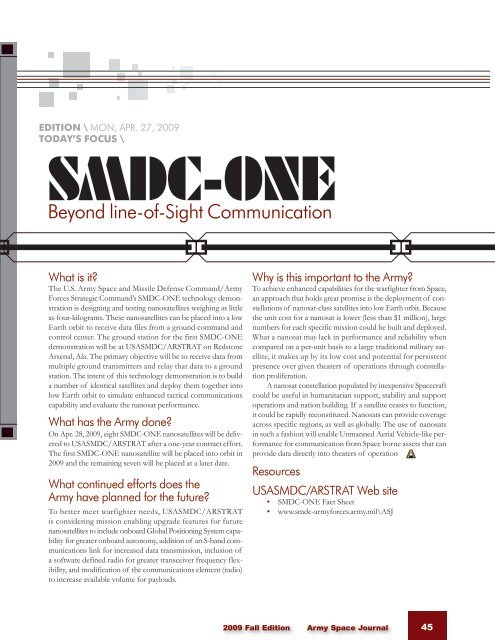Volume 8, Number 3 - Space and Missile Defense Command - U.S. ...
Volume 8, Number 3 - Space and Missile Defense Command - U.S. ...
Volume 8, Number 3 - Space and Missile Defense Command - U.S. ...
Create successful ePaper yourself
Turn your PDF publications into a flip-book with our unique Google optimized e-Paper software.
Edition \ Mon, Apr. 27, 2009<br />
Today’s Focus \<br />
SMDC-ONE<br />
Beyond line-of-Sight Communication<br />
What is it?<br />
The U.S. Army <strong>Space</strong> <strong>and</strong> <strong>Missile</strong> <strong>Defense</strong> Comm<strong>and</strong>/Army<br />
Forces Strategic Comm<strong>and</strong>’s SMDC-ONE technology demonstration<br />
is designing <strong>and</strong> testing nanosatellites weighing as little<br />
as four-kilograms. These nanosatellites can be placed into a low<br />
Earth orbit to receive data files from a ground comm<strong>and</strong> <strong>and</strong><br />
control center. The ground station for the first SMDC-ONE<br />
demonstration will be at USASMDC/ARSTRAT on Redstone<br />
Arsenal, Ala. The primary objective will be to receive data from<br />
multiple ground transmitters <strong>and</strong> relay that data to a ground<br />
station. The intent of this technology demonstration is to build<br />
a number of identical satellites <strong>and</strong> deploy them together into<br />
low Earth orbit to simulate enhanced tactical communications<br />
capability <strong>and</strong> evaluate the nanosat performance.<br />
What has the Army done?<br />
On Apr. 28, 2009, eight SMDC-ONE nanosatellites will be delivered<br />
to USASMDC/ARSTRAT after a one-year contract effort.<br />
The first SMDC-ONE nanosatellite will be placed into orbit in<br />
2009 <strong>and</strong> the remaining seven will be placed at a later date.<br />
What continued efforts does the<br />
Army have planned for the future?<br />
To better meet warfighter needs, USASMDC/ARSTRAT<br />
is considering mission enabling upgrade features for future<br />
nanosatellites to include onboard Global Positioning System capability<br />
for greater onboard autonomy, addition of an S-b<strong>and</strong> communications<br />
link for increased data transmission, inclusion of<br />
a software defined radio for greater transceiver frequency flexibility,<br />
<strong>and</strong> modification of the communications element (radio)<br />
to increase available volume for payloads.<br />
Why is this important to the Army?<br />
To achieve enhanced capabilities for the warfighter from <strong>Space</strong>,<br />
an approach that holds great promise is the deployment of constellations<br />
of nanosat-class satellites into low Earth orbit. Because<br />
the unit cost for a nanosat is lower (less than $1 million), large<br />
numbers for each specific mission could be built <strong>and</strong> deployed.<br />
What a nanosat may lack in performance <strong>and</strong> reliability when<br />
compared on a per-unit basis to a large traditional military satellite,<br />
it makes up by its low cost <strong>and</strong> potential for persistent<br />
presence over given theaters of operations through constellation<br />
proliferation.<br />
A nanosat constellation populated by inexpensive <strong>Space</strong>craft<br />
could be useful in humanitarian support, stability <strong>and</strong> support<br />
operations <strong>and</strong> nation building. If a satellite ceases to function,<br />
it could be rapidly reconstituted. Nanosats can provide coverage<br />
across specific regions, as well as globally. The use of nanosats<br />
in such a fashion will enable Unmanned Aerial Vehicle-like performance<br />
for communication from <strong>Space</strong> borne assets that can<br />
provide data directly into theaters of operation<br />
Resources<br />
USASMDC/ARSTRAT Web site<br />
• SMDC-ONE Fact Sheet<br />
• www.smdc-armyforces.army.mil\ASJ<br />
2009 Fall Edition Army <strong>Space</strong> Journal 45
















